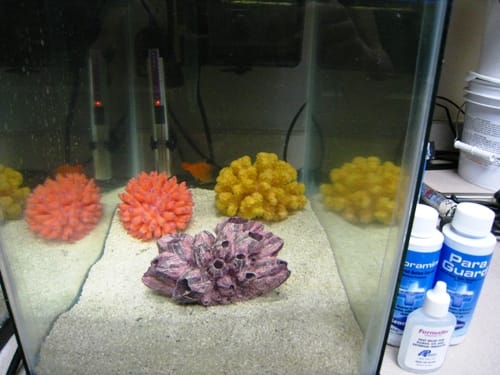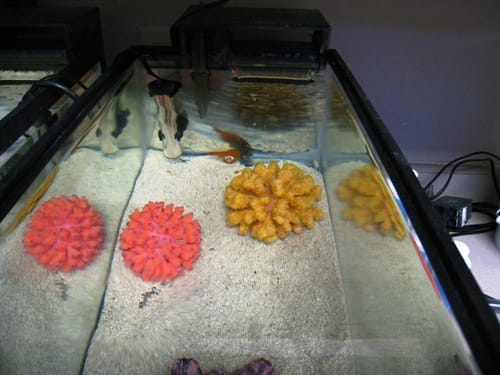It is a good practice to quarantine any new fish before adding it to your saltwater aquarium. If an established fish becomes infected with a bacteria, parasite or fungus, a quarantine tank makes a great fish hospital.
Quarantine New Fish
1. It is important to quarantine new fish because they become stressed after being transported and are more likely to show signs of disease. A quarantine tank is an easy way to treat and prevent diseases from infecting the rest of your fish.
2. After being shipped halfway around the world, fish often become malnourished. This is a good opportunity to fatten up your new fish with Vitamin Enriched Foods and boost its immune system with a Garlic Supplement.
3. It is difficult to catch a sick fish once it is already in your aquarium, and you may stress it and other fish while trying to remove it.
4. You can treat with more effective medications without having to worry about harming corals and other invertebrates. Medications containing copper are toxic to corals and reef invertebrates.
Quarantine Tank Supplies
1. 10 Gallon Aquarium – For treating one small fish, this is generally an appropriate size. Larger fish or multiple fish may require a larger aquarium or more frequent water changes.
2. Heater – Sometimes raising the aquarium’s temperature to 80 to 82 degrees can help eliminate some diseases.
3. Hang on the Back Filter or Hang on the Back Protein Skimmer – An Aquaclear makes an ideal Hang on the Back Filter for most quarantine systems. Other popular brands include Whisper and Penguin. Remember to discard the carbon included in most filters as it will remove the medications from the water.
4. Light – Optional – Fish will often become lighter in color without light, but generally keep the light off as it reduces stress and algae growth except during observation and feeding.
5. Live Sand – Optional – Some hobbyists like to use live sand in a quarantine tank because it hides reflections and creates a more natural environment. Any live sand used in a quarantine tank should not be reused in your display tank.
6. Live Rock – Optional – Some hobbyists like to use live rock in a quarantine tank to create a more natural structure. Any live rock used in a quarantine tank should not be reused in your display tank.
7. Decorations – Adding plastic plants, fake corals, or PVC tubes will give the fish extra hiding places and reduce stress.
8. Bacteria Culture – Using a bacteria culture, will help jump start a new quarantine system and can be added while the quarantine system is not in use to keep it cycled.
9. Medications – There are many medications available on the market, like Seachem Cupramine and Paraguard, which can be used to treat a wide variety of diseases, including Ich.
Set Up a Quarantine Tank
1. Thoroughly clean the aquarium with hot water. Don’t use bleach or soap.
2. Add Saltwater Mixed to a specific gravity of 1.016. Using a lower salinity or hyposalinity will treat many diseases. Please note, using established tank water will provide little help against rising ammonia in an uncycled aquarium. Most of the bacteria is contained in the substrate and not the water.
3. Heat water to 76-82 degrees.
4. Add live sand, live rock and other decorations.
5. After the sand settles, set up the hang on the back filter or protein skimmer.
6. Add the bacteria starter culture.
7. Add the proper medication; do not overdose as this will most likely kill your fish.
8. Acclimate your new or sick fish to the quarantine tank. Moving from a specific gravity of 1.025 to 1.016 may require several hours of drip acclimation.
Quarantine Tank Pictures


9. Monitor the fish. Some experts recommend six weeks in the quarantine tank, others will suggest as little as two weeks. If six weeks is too long, treat at least until the disease is gone and then continue to treat for at least one more week.
10. Continue to Test the Water for ammonia, nitrite and nitrate. Perform water changes as necessary.
11. Once you are convinced the fish is healthy, reintroduce it into your display aquarium. Moving from a specific gravity of 1.016 to 1.025 may require several hours of drip acclimation.
